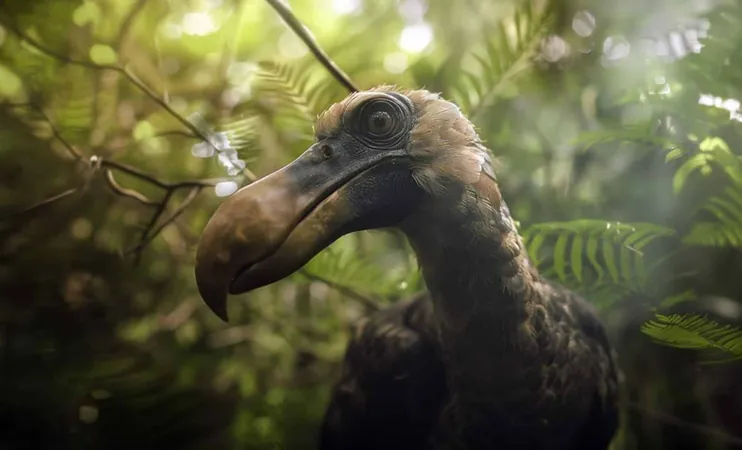
The Dodo Is Making a Comeback: A New Era for Extinct Species!
2025-04-07
Author: Kai
In an unprecedented endeavor to counter the consequences of extinction, Colossal Biosciences—a pioneering de-extinction company based in Texas—is taking the reins to revolutionize our understanding of wildlife conservation by resurrecting magnificent species that once thrived on our planet.
The dodo, woolly mammoth, and thylacine are at the forefront of this ambitious project, which promises to redefine biodiversity and the future of ecosystems. Using cutting-edge genetic engineering technologies, these long-lost animals could soon return to our world, with an exciting timeline projected for their revival.
The Dodo's Resurrection: A Flightless Bird's Return
Known for its tragic extinction in 1681, the dodo became a classic example of human-induced species loss. With no natural predators, this iconic flightless bird from Mauritius was ill-prepared for the sudden threat posed by sailors and invasive species. Fast forward over 300 years, Colossal Biosciences is now on an exhilarating journey to bring this unique bird back to life.
By employing DNA from a well-preserved dodo skull stored in the Natural History Museum of Denmark, scientists are sequencing its genome in hopes of creating a living dodo by 2028. Utilizing innovative gene-editing technologies such as CRISPR, they aim to manipulate the genetic material of the Nicobar pigeon, the dodo's closest living relative, to exhibit characteristics reminiscent of the dodo.
In a groundbreaking approach, the team intends to use chickens as surrogate parents for the first dodo-like chicks, providing a unique opportunity for these birds to grow with reproductive cells reflecting all the dodo's traits.
The Return of the Woolly Mammoth: The Giant's Comeback
The woolly mammoth project is generating buzz, capturing the imagination of scientists and nature enthusiasts alike. Linked closely to the Asian elephant with a staggering 98% genetic overlap, Colossal is on a mission to revive this legendary creature by modifying the small percentage of the genome that differentiates them.
Scientists expect to create mammoth-like embryos by late 2026, with the first births aiming for 2028. The plan involves altering Asian elephant cells to include mammoth genes and using advanced cloning techniques to implant these modified cells into an elephant's egg. The outcome? A new breed of elephant equipped with the grandeur and traits of the woolly mammoth, complete with thick fur and layers of blubber to thrive in cold environments.
Reviving the Thylacine: The Tasmanian Tiger's Comeback
The thylacine, or Tasmanian tiger, distinctly recognizable by its striking stripes, sadly went extinct in the 20th century. This majestic carnivorous marsupial was a top predator in its environment, and now, Colossal is striving to resurrect this iconic species using the dunnart, a much smaller marsupial, as its genetic template.
This ambitious endeavor will require extensive modifications to the dunnart's DNA, reshaping its size, jaw structure, and skin markings to recreate the thylacine’s physical traits. However, this project ushers in a host of ethical considerations and ecological ramifications about reintroducing such animals into modern-day ecosystems.
As Colossal delves into the complexities of de-extinction, the journey raises profound questions about biodiversity and conservation ethics. While the arena of genetic engineering offers unprecedented possibilities, the challenges ahead are manifold. The revivals of these historical species not only promise to enrich our biodiversity but may also alter the natural landscape in significant ways. Will we embrace this new era of bringing back the past, or tread carefully as we rethink our relationship with nature? Stay tuned, as history might just be on the verge of rewriting itself!



 Brasil (PT)
Brasil (PT)
 Canada (EN)
Canada (EN)
 Chile (ES)
Chile (ES)
 Česko (CS)
Česko (CS)
 대한민국 (KO)
대한민국 (KO)
 España (ES)
España (ES)
 France (FR)
France (FR)
 Hong Kong (EN)
Hong Kong (EN)
 Italia (IT)
Italia (IT)
 日本 (JA)
日本 (JA)
 Magyarország (HU)
Magyarország (HU)
 Norge (NO)
Norge (NO)
 Polska (PL)
Polska (PL)
 Schweiz (DE)
Schweiz (DE)
 Singapore (EN)
Singapore (EN)
 Sverige (SV)
Sverige (SV)
 Suomi (FI)
Suomi (FI)
 Türkiye (TR)
Türkiye (TR)
 الإمارات العربية المتحدة (AR)
الإمارات العربية المتحدة (AR)